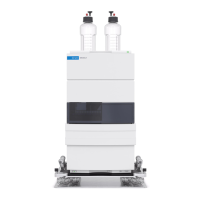324 1220 Infinity II LC System User Manual
11
Maintenance and Repair
Algae Growth in HPLC Systems
Symptoms observed with the Agilent 1220 Infinity II LC
In contrast to other HPLC systems, such as HP 1090 and HP 1050 Series,
which use helium degassing, algae have a better chance to grow in systems
such as the Agilent 1220 Infinity II LC, where helium is not used for degassing
(most algae need oxygen and light for growth).
The presence of algae in the Agilent 1220 Infinity II LC can cause the following
to occur:
• Blockage of PTFE frits (pack of 5) (01018-22707) (purge valve assembly)
and column filter, causing increased system pressure. Algae appear as
white or yellowish-white deposits on filters. Typically, black particles from
the normal wear of the piston seals do not cause the PTFE frits to block
over short-term use.
• Short lifetime of solvent filters (bottle head assembly). A blocked solvent
filter in the bottle, especially when only partly blocked, is more difficult to
identify and may show up as problems with gradient performance,
intermittent pressure fluctuations etc.
• Algae growth may also be the possible source of failures of the ball valves
and other components in the flow path.
Preventing and/or reducing the algae problem
• Always use freshly prepared solvents, especially use demineralized water
that has been filtered through about 0.2 μm filters.
• Never leave mobile phase in the instrument for several days without flow.
• Always discard old mobile phase.
• Use the Solvent bottle, amber (9301-1450) supplied with the instrument for
your aqueous mobile phase.
• If possible, add a few mg/l sodium azide or a few percent organic solvent to
the aqueous mobile phase.

